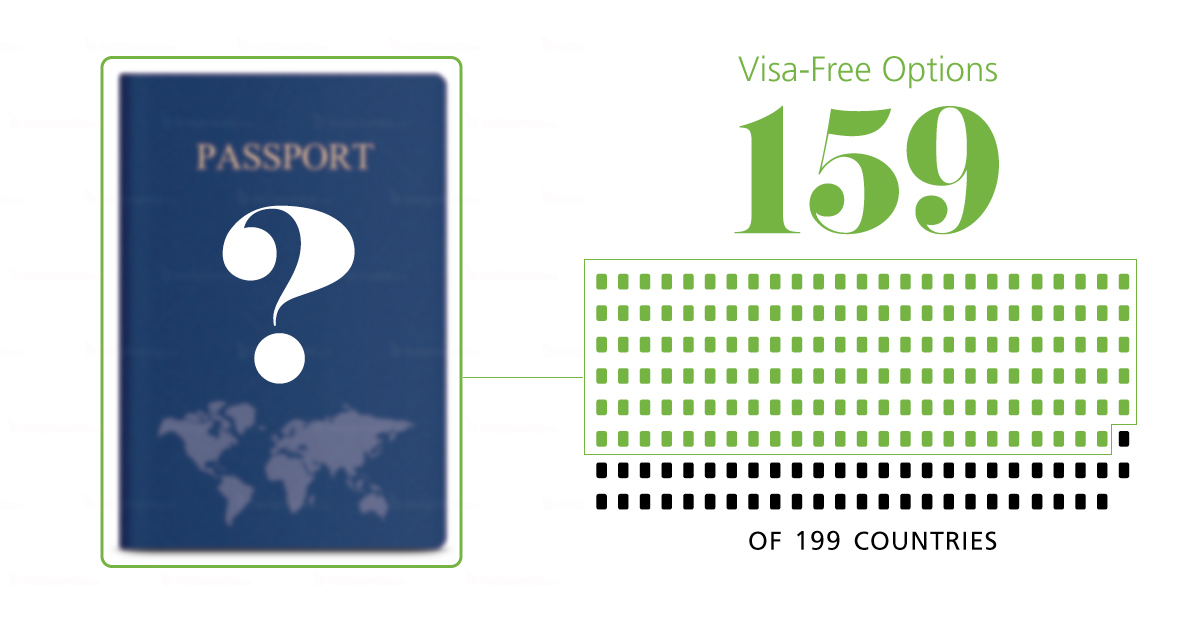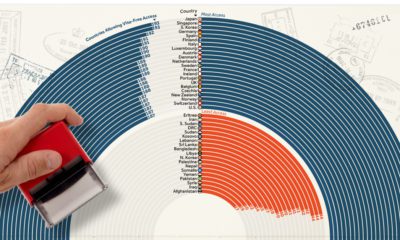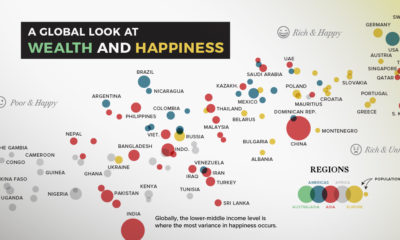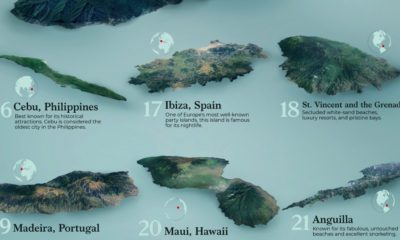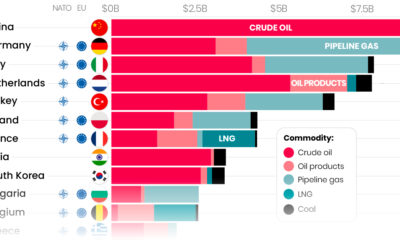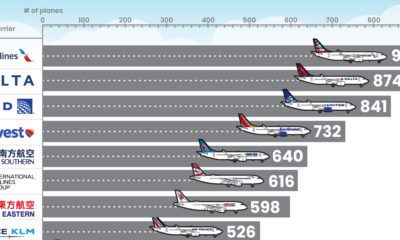The World’s Most Powerful Passports
Which passports are travel assets, and which are liabilities?
The Chart of the Week is a weekly Visual Capitalist feature on Fridays. Whether you seek to explore distant lands, or you just want to sit on a remote island beach with a margarita, your passport can be your biggest travel asset. The right document grants you visa-free access to over 150+ countries, and makes applying for entry to the other places a short and easy afterthought. But a passport can also be your biggest liability. Having a passport from the wrong place means travel is extremely restricted to just a few countries – and these are generally not the places travelers want to go, anyways. Even worse, passports on the lower end of the spectrum are also heavily scrutinized at entry-points around the world. If you have a document from Afghanistan, Sri Lanka, Lebanon, or several other countries, there may be many hoops for you to jump through to get to your final destination.
The Most Powerful Passport
According to the Passport Index, the distinction for the world’s most powerful passport actually ends up as a tie between Germany and Singapore. Both have unparalleled access to visa-free entries, each with a list of 159 countries that citizens can go to without any hassles. Like Germany, most other Western European nations do similarly well in the visa-free department: In Asia, however, things are quite different. After Singapore and a few other countries (Japan, South Korea, and Malaysia), things drop off faster. Further down the list in Asia, citizens of certain countries find themselves in even a tougher place, especially if they reside in the Middle East. Countries like Afghanistan (22), Pakistan (25), Iraq (26), Syria (30), and Bangladesh (35) have some of the shortest lists of visa-free countries that citizens have access to.
North America
In North America, the United States and Canada both have powerful passports with 157 and 155 visa-free options respectively. However, they differ in a few key areas. Americans have visa-free access to Armenia, Equatorial Guinea, Palau, the Marshall Islands, and the Central African Republic, while Canadians have visa-free access to Bolivia, Venezuela, and Gambia.
Don’t Own These Passports…
We alluded earlier to the fact that a passport can also be a traveler’s biggest liability. Here are some of the countries that you would likely not want to have a passport from: on Even while political regimes across these countries have changed over time, they’ve largely followed a few different types of governance. Today, every country can ultimately be classified into just nine broad forms of government systems. This map by Truman Du uses information from Wikipedia to map the government systems that rule the world today.
Countries By Type of Government
It’s important to note that this map charts government systems according to each country’s legal framework. Many countries have constitutions stating their de jure or legally recognized system of government, but their de facto or realized form of governance may be quite different. Here is a list of the stated government system of UN member states and observers as of January 2023: Let’s take a closer look at some of these systems.
Monarchies
Brought back into the spotlight after the death of Queen Elizabeth II of England in September 2022, this form of government has a single ruler. They carry titles from king and queen to sultan or emperor, and their government systems can be further divided into three modern types: constitutional, semi-constitutional, and absolute. A constitutional monarchy sees the monarch act as head of state within the parameters of a constitution, giving them little to no real power. For example, King Charles III is the head of 15 Commonwealth nations including Canada and Australia. However, each has their own head of government. On the other hand, a semi-constitutional monarchy lets the monarch or ruling royal family retain substantial political powers, as is the case in Jordan and Morocco. However, their monarchs still rule the country according to a democratic constitution and in concert with other institutions. Finally, an absolute monarchy is most like the monarchies of old, where the ruler has full power over governance, with modern examples including Saudi Arabia and Vatican City.
Republics
Unlike monarchies, the people hold the power in a republic government system, directly electing representatives to form government. Again, there are multiple types of modern republic governments: presidential, semi-presidential, and parliamentary. The presidential republic could be considered a direct progression from monarchies. This system has a strong and independent chief executive with extensive powers when it comes to domestic affairs and foreign policy. An example of this is the United States, where the President is both the head of state and the head of government. In a semi-presidential republic, the president is the head of state and has some executive powers that are independent of the legislature. However, the prime minister (or chancellor or equivalent title) is the head of government, responsible to the legislature along with the cabinet. Russia is a classic example of this type of government. The last type of republic system is parliamentary. In this system, the president is a figurehead, while the head of government holds real power and is validated by and accountable to the parliament. This type of system can be seen in Germany, Italy, and India and is akin to constitutional monarchies. It’s also important to point out that some parliamentary republic systems operate slightly differently. For example in South Africa, the president is both the head of state and government, but is elected directly by the legislature. This leaves them (and their ministries) potentially subject to parliamentary confidence.
One-Party State
Many of the systems above involve multiple political parties vying to rule and govern their respective countries. In a one-party state, also called a single-party state or single-party system, only one political party has the right to form government. All other political parties are either outlawed or only allowed limited participation in elections. In this system, a country’s head of state and head of government can be executive or ceremonial but political power is constitutionally linked to a single political movement. China is the most well-known example of this government system, with the General Secretary of the Communist Party of China ruling as the de facto leader since 1989.
Provisional
The final form of government is a provisional government formed as an interim or transitional government. In this system, an emergency governmental body is created to manage political transitions after the collapse of a government, or when a new state is formed. Often these evolve into fully constitutionalized systems, but sometimes they hold power for longer than expected. Some examples of countries that are considered provisional include Libya, Burkina Faso, and Chad.

